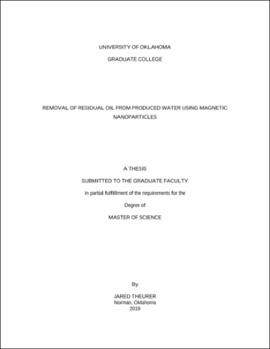| dc.contributor.advisor | Ahmed, Ramadan | |
| dc.contributor.author | Theurer, Jared | |
| dc.date.accessioned | 2019-08-28T17:53:20Z | |
| dc.date.available | 2019-08-28T17:53:20Z | |
| dc.date.issued | 2019-08 | |
| dc.identifier.uri | https://hdl.handle.net/11244/321399 | |
| dc.description.abstract | The production of wastewater during hydrocarbon recovery is an unresolvable factor of the oil and gas industry. Oil wells in the US produce on average, nearly 10 barrels of water for every 1 barrel of oil. Most of the produced water is reinjected back into the formation. However, recent studies may have linked increases in localized seismic activity to corresponding rises in wastewater well injection. Consequently, environmental discharge or reuse regulations are becoming more rigorous for produced water. Produced wastewater often originates from areas where water repurposing is an attractive option due to limited water resources in the area. Current water treatment solutions have not been universally successful as practical solutions due to high treatment material costs, long treatments cycles, and the production of additional environmental waste. Therefore, the need for a cost-effective, environmentally safe, and low waste producing water treatment method may change the outcome of millions of barrels of unusable water produced each year. This study explores the recent advancements in nanotechnology to treat oil field wastewaters and demonstrates a newly discovered material’s ability to reduce residual oil concentrations below discharge limits. Iron oxides are commonly found in the environment and display a unique characteristic of superparamagnetism that is desirable for produced water treatment. The inherent magnetism of these particles allows them to be physically manipulated by a magnetic field and can be used to separate trapped oil from oil-in-water emulsions. The principal objective of this study is to examine the abilities of magnetite (Fe2O4) and maghemite (γ-Fe2O3) nanoparticles to reduce residual oil concentrations in produced water samples containing both dispersed and dissolved oil. Amine-coated magnetite nanoparticles have shown oil removal capabilities in previous studies. The nanoparticles for this study were sourced from a local laboratory and also purchased commercially for comparison. The characteristics of the nanoparticles were measured and analyzed for comparative analysis and particles selection to optimize the water treatment process. Iron oxide nanoparticles used in water treatment tests relied on carefully designed oil removal experiments, emulsion production, and nanoparticle recovery and recyclability tests. The oil removal tests were conducted with prepared oil-water emulsions at known concentrations and with locally sourced produced water samples. The oil removal tests include the combination of an oil-water emulsion and dispersed nanoparticles in varying concentrations. After mixing the solution, the cloudy oil-water emulsions were made clear almost immediately when an external magnet was applied, indicating good oil-nanoparticle adherence. Oil concentration measurements via non-dispersive infrared spectroscopy confirmed the removal of oil as seen visually in the tests. Initial emulsion oil concentrations were reduced after nanoparticle treatment from 1,000 ppm to less than 10 ppm (>99% oil removal efficiencies). The oil removed from the O/W emulsions was then separated from the nanoparticles to be reused in additional treatment cycles. Maghemite maintained >98% oil removal efficiencies for up to at least ten cycles. These test results confirm iron oxide nanoparticles as a viable treatment solution for produced waters and most importantly, provide an environmentally safe method for removing oil contaminants from oilfield waters without the production of additional waste. | en_US |
| dc.language | en | en_US |
| dc.subject | Engineering, Petroleum. | en_US |
| dc.subject | Engineering, Chemical. | en_US |
| dc.subject | Iron Oxide Nanoparticles | en_US |
| dc.subject | Produced Water Treatment | en_US |
| dc.title | Removal of Residual Oil From Produced Water Using Magnetic Nanoparticles | en_US |
| dc.contributor.committeeMember | Mirazizi, Hamidreza Karami | |
| dc.contributor.committeeMember | Shiau, Benjamin (Bor-Jier) | |
| dc.date.manuscript | 2019-08 | |
| dc.thesis.degree | Master of Science | en_US |
| ou.group | Mewbourne College of Earth and Energy::Mewbourne School of Petroleum and Geological Engineering | en_US |
| shareok.orcid | 0000-0002-9808-3531 | en_US |
| shareok.nativefileaccess | restricted | en_US |
